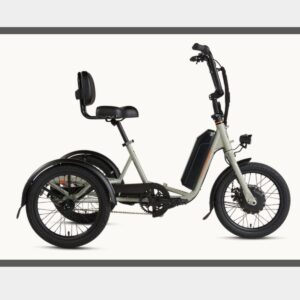Seattle-based e-bike company Rad Power Bikes is the subject of a serious warning issued Monday by the U.S. Consumer Product Safety Commission (CPSC). Rad Power has issued their own statement that “strongly disagrees” with the government statement. Rad Power is one of the largest e-bike brands in North America with thousands of customers in the Portland region. Note this is a warning and not a recall. The CPSC says they tried to perform a recall, but Rad Power has “refused to agree to an acceptable recall.”
In a press release, the CPSC said people who own certain models of Rad Power batteries should, “immediately” stop using them, “because the batteries pose a risk of serious injury and death.” The specific battery model numbers are; RP-1304 and HL-RP-S1304.
Here’s more from the CPSC:
“The hazardous batteries can unexpectedly ignite and explode, posing a fire hazard to consumers, especially when the battery or the harness has been exposed to water and debris. CPSC is aware of 31 reports of fire, including 12 reports of property damage totaling approximately $734,500. Some of these incidents occurred when the battery was not charging, the product was not in use, and the product was in storage.
The batteries were sold with the following Rad Power Bikes e-bike models and as replacement batteries: RadWagon 4, RadCity HS 4, RadRover High Step 5, RadCity Step Thru 3, RadRover Step Thru 1, RadRunner 2, RadRunner 1, RadRunner Plus, and RadExpand 5. The battery model number (HL-RP-S1304 or RP-1304) is printed on a label on the back or rear of the battery. The batteries were sold on RadPowerBikes.com and at Best Buy stores and independent bike shops nationwide for about $550 (replacement batteries) or between $1,500 and $2,000 (when sold with e-bikes).”
The CPSC says if you have one of these batteries you should remove it from the bike and dispose of the battery in accordance with local hazardous waste procedures. The CPSC says Rad Power has refused to agree to acceptable recall mitigations and that “given its financial situation, Rad Power Bikes… is unable to offer replacement batteries or refunds to all consumers.” Just two weeks ago, news reports detailed that Rad Power could be forced to shut down in January if they were unable to secure new funding and ownership. Read the full CPSC recall notice here.
In response to the warning, Rad Power says they stand behind their batteries and, “strongly disagrees with the CPSC’s characterization of certain Rad batteries as defective or unsafe.” “Reputable, independent third-party labs tested Rad’s batteries, both as part of our typical product testing and again during the CPSC investigation,” the statement continues, “and confirmed compliance with the highest industry standards. Our understanding is that the CPSC does not dispute the conclusions of these tests. It is also our understanding that the battery itself was not independently examined per industry-accepted test standards.”
Rad Power claims that the CPSC has taken battery issues out of context. “The incident rate associated with the batteries in the CPSC’s notice is a fraction of one percent,” Rad Power says. The company goes on to explain that e-bike batteries post inherent risks when not stored or used properly. Read Rad Power’s full statement, here.
Risks of e-bike battery explosions and fires have simmering in the bike industry for years — but nearly all publicized cases have happened to lower-priced batteries from unregulated manufacturers. Even so, I know of at least one local e-bike shop that has very meticulous battery storage methods, including a fireproof metal locker placed outside their retail building.
Asked for battery safety advice, The eBike Store shared the tips below:
- Look for UL approval.
- Only charge battery when it’s at room temp.
- Don’t charge unattended.
- Don’t leave battery plugged into charger indefinitely.
- Try to keep between 20-80% charge when possible.
- Don’t drop it.
- Don’t use an aftermarket or unapproved charger.
- After a crash or drop, let the battery sit for seven days in a non-flammable area.
Stay tuned for more coverage.







Thanks for reading.
BikePortland has served this community with independent community journalism since 2005. We rely on subscriptions from readers like you to survive. Your financial support is vital in keeping this valuable resource alive and well.
Please subscribe today to strengthen and expand our work.
Does anyone know if these vehicles are ridable without the motor? Given that you can hear the tire noise a block away, I’m guessing “technically, yes”.
Depends on which model, but they are all very heavy. At least one of them is ergonically inconvenient to pedal.
I have a RadCity, and I have ridden it with the assist turned off for many miles. It’s heavy and there is a bit of drag, but manageable. If you removed the battery and replaced the back wheel with a non-motorized wheel, it should ride like a normal bike.
Bankruptcy coming in 3, 2, 1, …
They have already laid off staff and said warned they may be shutting down in January.
Reminds me of the scene from “I, Robot”, there’s always going to be some risk associated with storing that much energy in one place, but it’s going to take some time to catch up with safety protocols like how we handle gasoline.
https://www.youtube.com/watch?v=4NAU-UyiJ8A
Exploding e-waste.
That’s all I see when I look at a cheap e-bike.
One piece of advice I got from one of my bikiest sources before buying an e-bike was to go for a “standard” battery rather than one proprietary to the bike manufacturer. It was easy to take this advice to heart, as someone I know had recently plunked down thousands of dollars for a fancy-shmancy European e-bike with a proprietary system, from a company that went bankrupt *weeks* after my friend’s bike arrived, rendering the bike unusable. It’s still sitting in his basement years later! When I bought my e-bike from the wonderful folks at Splendid Cycle, we discussed exactly what parts were proprietary, and everything they said reassured me that if the bicycle manufacturer went out of business, I could still get the battery or other parts replaced as needed. Two years and nearly 5,000 miles later, it hasn’t been an issue, but I don’t think I’d buy or recommend a friend buy a bike with a proprietary battery. (Lucky for me, I don’t have to shop for an automobile … even more proprietary bits n pieces on those.)
Finding spare parts for a car is generally easier than for an e-bike. Car manufacturers are required to stock parts for a fixed amount of time, and, in many cases, third party parts suppliers make compatible parts. There is also a strong second-hand parts market for many car models.
Bosch and Shimano motor/battery systems for the win.
When news of ebike battery fires started popping up a few years ago, I saw advice to only buy an ebike if it came with a battery that was UL certified. I don’t see that icon on the battery, but does anyone know for sure if Rad has pursued that certification or not?
I think it depends on which model you have and when you bought it Joan. Rad has a post on their website from June of 2024 discussing that they had gotten UL certification for Radster Road, Radster Trail, RadWagon 5 and RadExpand 5 Plus. The same article notes that all Rad ebikes are either UL Certified or ACT compliant. I would expect any battery that had been certified by the UL to have a sticker on it indicating that it had passed as seen here in this image.
Yes, Rad eventually started selling “Safe Shield” batteries that were UL certified. The batteries that CPSC is warning about are older, from before they rolled those out.
If you’re concerned about your e-bike battery (recall or not) fire proof bags are relatively inexpensive. I don’t know where you can find one locally but I bought one online after inheriting a DIY e-bike.
I’m sure Nomad Cycles could easily build and sell people replacements, given the Bafang motors on Rad Power machines are ubiquitous.